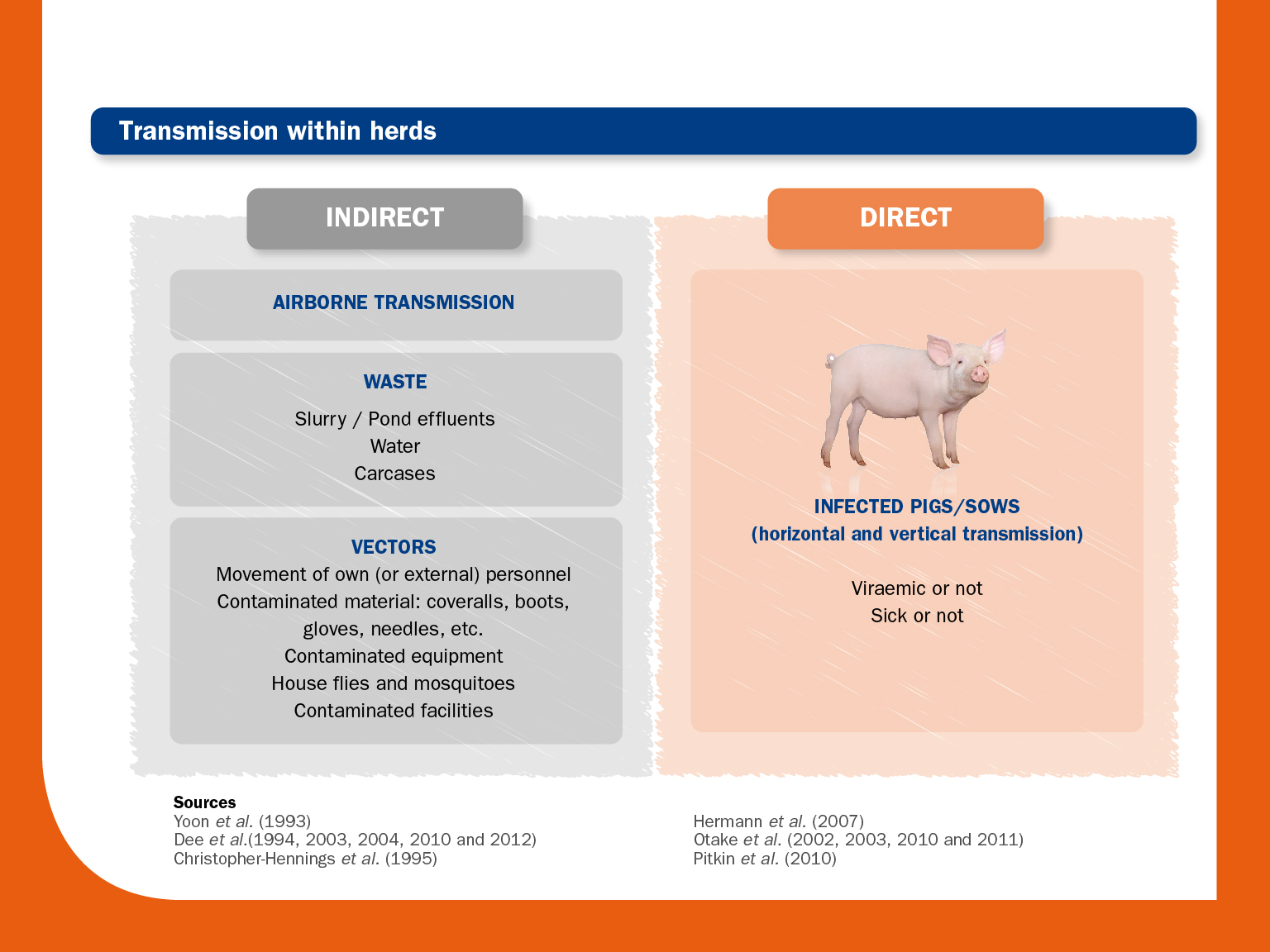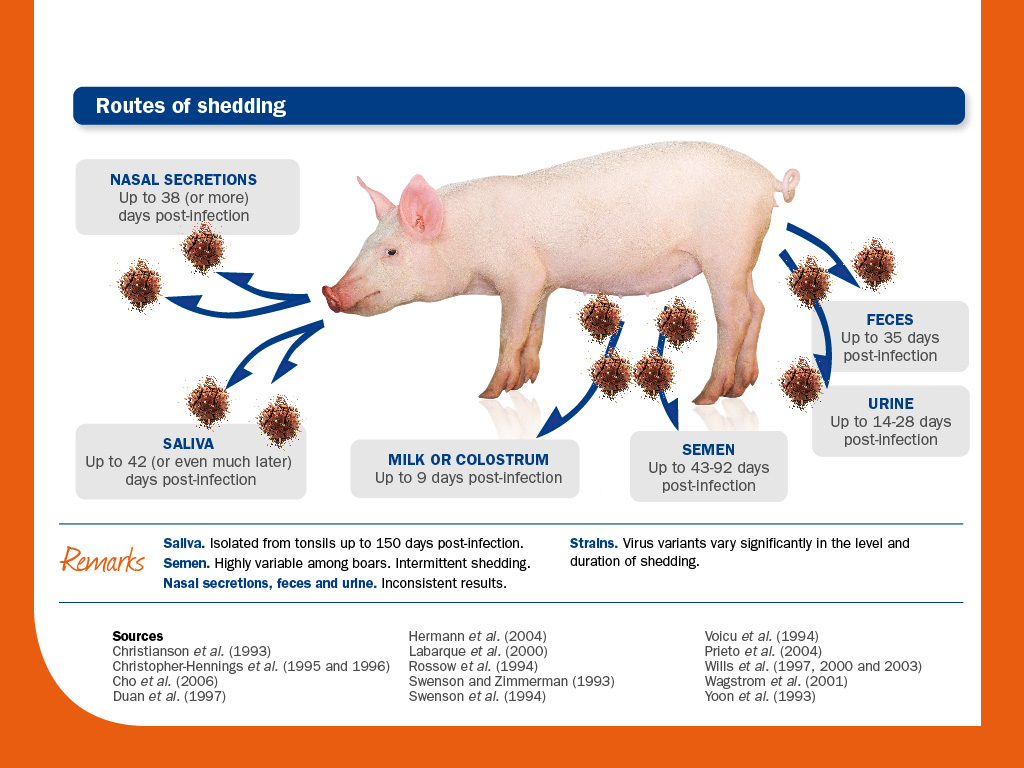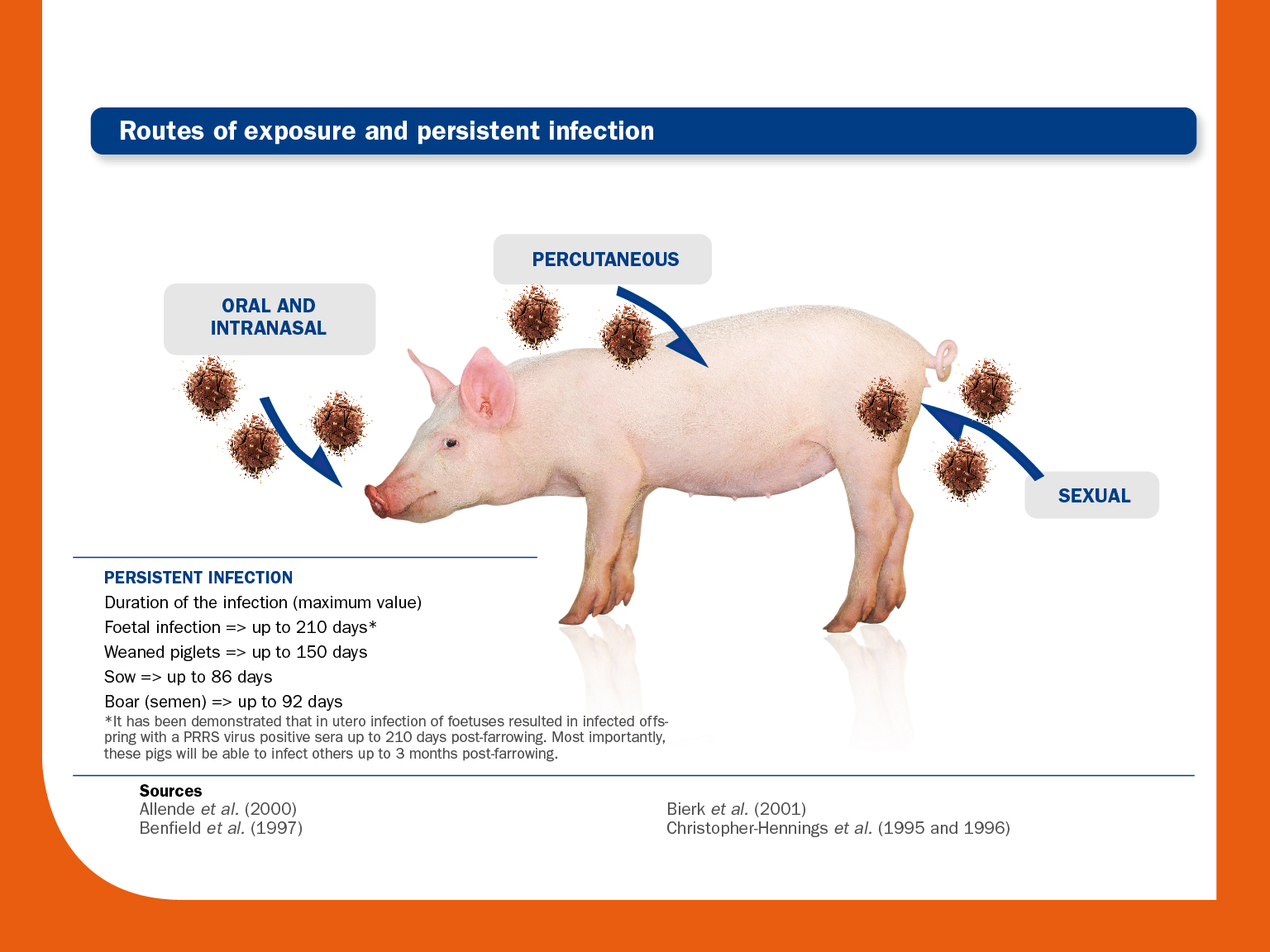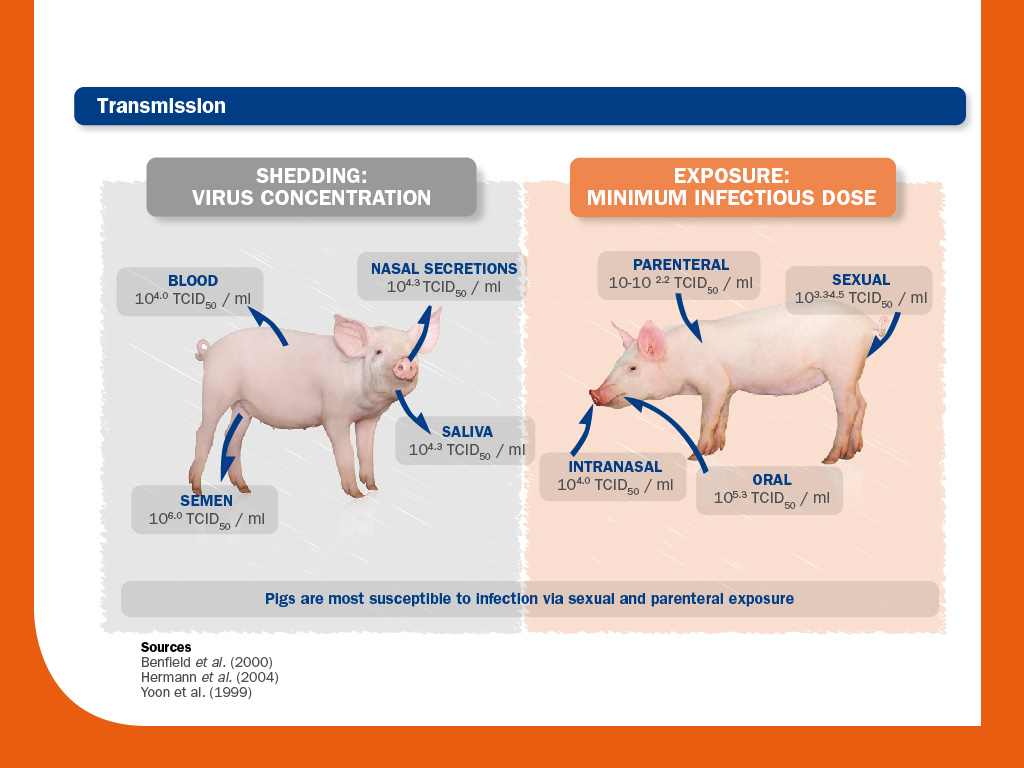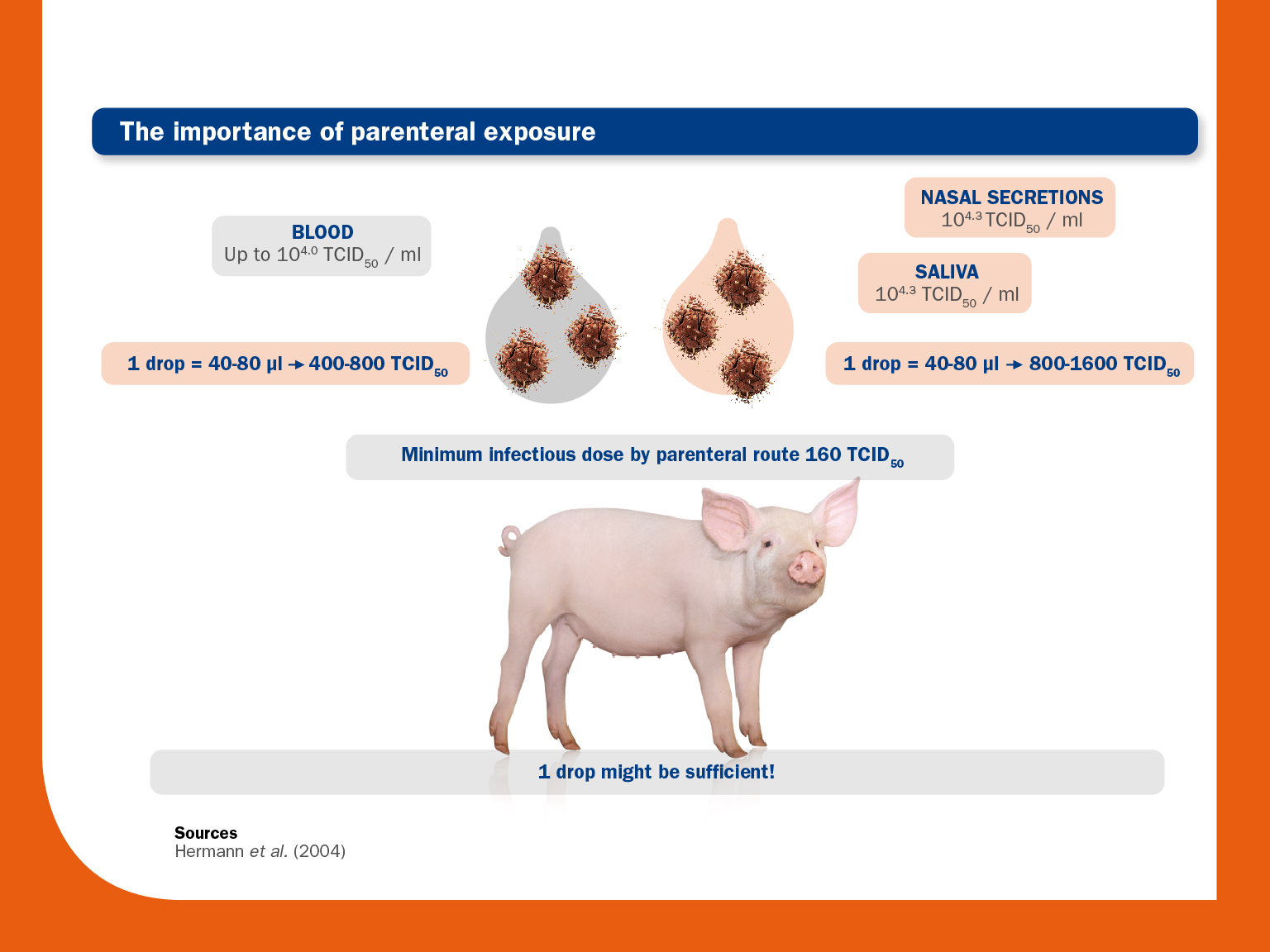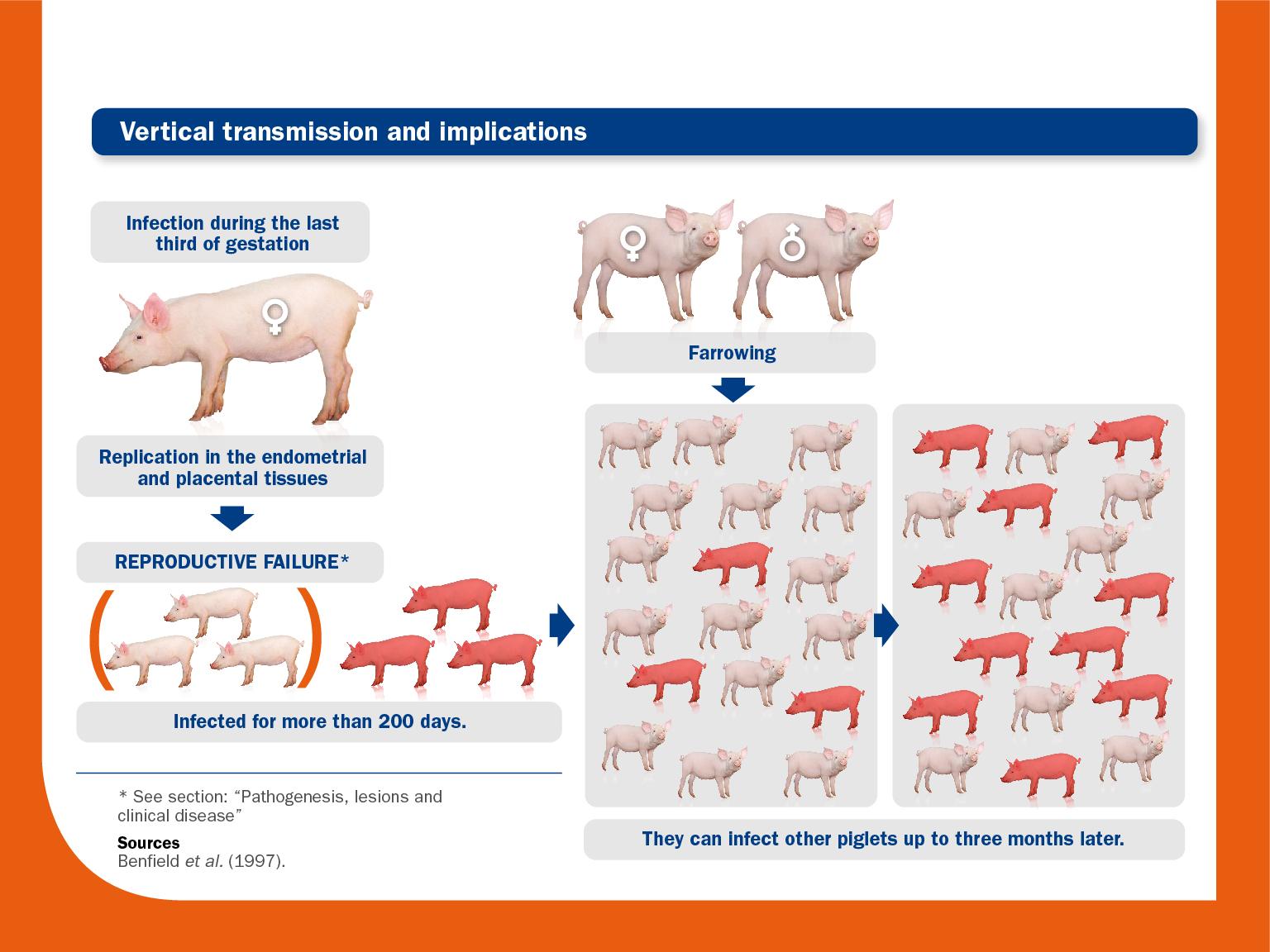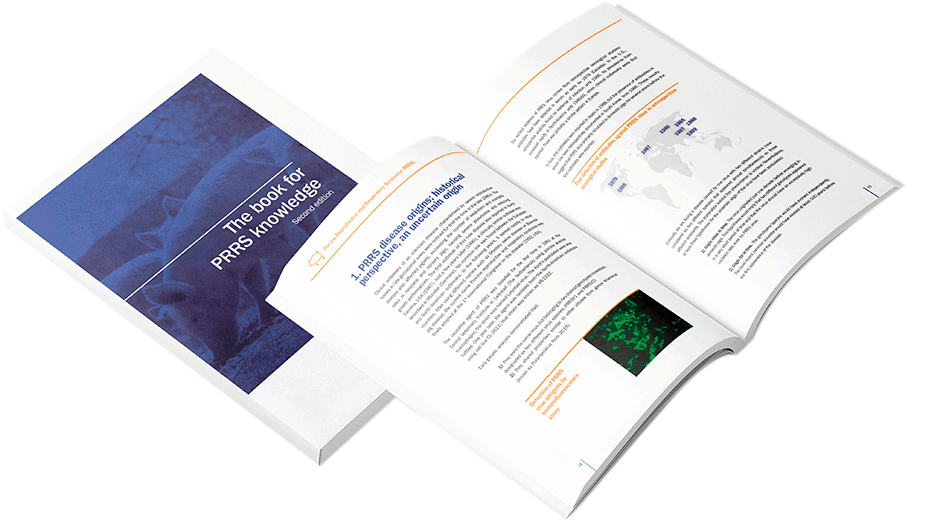1. Direct Transmission:
a) Horizontal transmission
a.1) Shedding routes:
Infected pigs can shed virus from multiple routes and for long time; mainly by saliva and semen; less frequently in milk and colostrum, and rarely and sporadically in nasal secretions, urine and feces.
The amount of virus shed, together with the duration of the shedding, vary significantly among strains.
a.2) Exposure routes:
Swine can be infected by several exposure routes , including oral, intranasal, percutaneous, and sexual (intrauterine and vaginal).
The probability of infection is highly dependent on the route and the dose of virus. Also, differences among strains are observed for all transmission routes.
a.3) Chronic/persistent infection (carrier animals):
The virus can be detected in blood for long periods of time.
The length of viraemia is strongly influenced by the strain and the animal’s age; it may extend during weeks in piglets (up to 90 days), whereas in adult pigs it may last for only a few days.
After viraemia, PRRS virus can persist for several weeks, particularly in tonsils and other lymphoid tissues.
Although most pigs clear PRRS virus within 90 or 120 days, some may remain persistently infected for several months (virus may be isolated from tonsils up to 150 days post-infection). Persistent infection occurs at all ages, but maximum values have been observed in in utero infected fetuses.
It has been suggested that the persistence of PRRS virus involves continuous viral replication; not being a true steady-state of persistent infection.
Obviously, prolonged viraemia and persistent infection increase the possibility of transmission. As other members of the family Arteriviridae, pigs recovered from viraemia and/or acute phase can shed PRRS virus at low levels or intermittently.
Therefore, a negative result for viraemia or serum antibodies in a previously infected pig does not rule out that the animal could be shedding the virus.
a.4) Importance of semen in PRRS virus transmission:
Semen can play a crucial role in PRRS virus transmission. This is due to the extensive use of artificial insemination and the special features of the virus shed by this route.
As a matter of fact, the amount of virus necessary to infect a susceptible sow by sexual exposure tends to be much lower that the amount of virus present in semen from an infected boar.
Though viraemia usually is very short in boars, from a few days to a maximum of two-to-three weeks, they can shed the virus in semen several weeks after infection.
Moreover, PRRS virus can be isolated from bulbourethral gland of boars up to three months post infection, suggesting that the reproductive tract could play a significant role in the persistence of the virus.
Therefore, viraemia is not an adequate indicator of virus shedding.
Nevertheless, transmission by semen appears more likely to occur at early stages of infection due to the high titres of virus in the semen.
It is also important to note that high variability in virus shedding among boars is observed, and that boars are intermittent shedders.
Consequently, a negative isolated PCR result in serum or semen does not rule out the possibility of shedding by this route; more than one sample from a given boar should be analysed at different time periods.
a.5) Parental exposure:
Pigs are extremely susceptible to infection by parenteral exposure; very few PRRS virus particles are sufficient to infect pigs by this route (10-102.2 TCID50/ml).
Therefore, any event, practice or contaminated material that could affect the integrity of the skin barrier can potentially facilitate the transmission of the virus, such as: teeth clipping, ear notching, tail docking, inoculations with medications (needles) etc…
Infection can occur after the reuse of the needle employed to vaccinate infected pigs. In addition, because the virus is consistently present in oral fluids, normal pig social behaviour and aggressive interactions (bites, scrapes, abrasions…) can also result in parenteral infection.
b) Vertical transmission:
Sows can transmit the virus to their offspring by direct contact (horizontal transmission) and/or by transplacental route (vertical transmission).
Regarding vertical transmission, the virus can efficiently cross the placental barrier in the last period of pregnancy. As a result, fetal death can occur; alternatively, piglets that survive pregnancy are usually weak, and remain infected.
As we have stated before, piglets infected during the fetal phase could remain positive for a long time and infect other piglets as late as three months post-farrowing, contributing to the spread of the infection.
2. Indirect transmission
Several routes of indirect transmission by fomites and contaminated residues, as well as airborne transmission, have been demonstrated (please see the point “Transmission between herds”.
Within the herd, we should pay particular attention to hands/gloves, coveralls, boots, and mainly to needles, since pigs are most susceptible to infection via parenteral exposure.
© Laboratorios Hipra, S.A. 2024. All Rights Reserved.
No part of this website or any of its contents may be reproduced, copied, modified or adapted, without the prior written consent of HIPRA.
- Albina E. Epidemiology of porcine reproductive and respiratory syndrome (PRRS): an overview. Vet Microbiol. 1997, 55:309-16.
- Albina E, Carrat C, Charley B. Interferon-alpha response to swine arterivirus (PoAV), the porcine reproductive and respiratory syndrome virus. J Interferon Cytokine Res. 1998, 18:485-90.
- Allende R, Laegreid WW, Kutish GF, Galeota JA, Wills RW, Osorio FA. Porcine reproductive and respiratory syndrome virus: description of persistence in individual pigs upon experimental infection. J Virol. 2000, 74:10834-7.
- Andino R, Domingo E. Viral quasispecies. 2015, 479-480C:46-51.
- Arruda AG, Friendship R, Carpenter J, Hand K, Ojkic D, Poljak Z. Investigation of the Occurrence of Porcine Reproductive and Respiratory Virus in Swine Herds Participating in an Area Regional Control and Elimination Project in Ontario, Canada. Transbound Emerg Dis. 2015, Mar 11.
- Benfield DA, Christopher-Hennings J, Nelson EA, Rowland RR. , Nelson JK, Chase CL, Rossow KD, Collins JE. Persistent fetal infection of PRRS virus. In Proceedings of the28th Annual Meeting of the American Association of Swine. 1997: 455-8.
- Benfield D, Nelson J, Rossow K, Nelson C, Steffen M, Rowland R. Diagnosis of persistent or prolonged porcine reproductive and respiratory syndrome virus infections. Vet Res. 2000, 31:71.
- Benfield DA, Nelson C, Steffen M, Rowland RRR. Transmission of PRRSV by artificial insemination using extended semen seeded with different concentrations of PRRSV. Proceeding of the American Association of Swine Practitioners. 2000:405-408.
- Bierk MD, Dee SA, Rossow KD, Otake S, Collins JE, Molitor TW. Transmission of porcine reproductive and respiratory syndrome virus from persistently infected sows to contact controls. Can J Vet Res. 2001, 65:261-6.
- Blaha T. The “colorful” epidemiology of PRRS. Vet Res. 2000, 31:77-83.
- Brockmeier SL, Lager KM. Experimental airborne transmission of porcine reproductive and respiratory syndrome virus and Bordetella bronchiseptica. Vet Microbiol. 2002, 89:267-75.
- Brito B, Dee SA, Wayne S, Alvarez J, Perez A. Genetic diversity of PRRS virus collected from air samples in four different regions of concentrated swine production during a high incidence season. Viruses. 2014, 6:4424-36.
- Charpin C, Mahé S, Keranflec’h A, Belloc C, Cariolet R, Le Potier MF, Rose N. Infectiousness of pigs infected by the Porcine Reproductive and Respiratory Syndrome virus (PRRSV) is time-dependent. Vet Res.2012, 43:69.
- Cho JG, Dee SA, Deen J, Guedes A, Trincado C, Fano E, Jiang Y, Faaberg K, Collins JE, Murtaugh MP, Joo HS. Evaluation of the effects of animal age, concurrent bacterial infection, and pathogenicity of porcine reproductive and respiratory syndrome virus on virus concentration in pigs. Am J Vet Res. 2006, 67:489-93.
- Cho JG, Dee SA. Porcine reproductive and respiratory syndrome virus. Theriogenology. 2006, 66:655-62.
- Cho JG, Deen J, Dee SA. Influence of isolate pathogenicity on the aerosol transmission of Porcine reproductive and respiratory syndrome virus. Can J Vet Res. 2007, 71:23-7.
- Christianson WT, Choi CS, Collins JE, Molitor TW, Morrison RB, Joo HS. Pathogenesis of porcine reproductive and respiratory syndrome virus infection in mid-gestation sows and fetuses. Can J Vet Res. 1993, 57:262-8.
- Christopher-Hennings J, Nelson EA, Hines RJ, Nelson JK, Swenson SL, Zimmerman JJ, Chase CL, Yaeger MJ, Benfield DA. Persistence of porcine reproductive and respiratory syndrome virus in serum and semen of adult boars. J Vet Diagn Invest. 1995, 7:456-64.
- Christopher-Hennings J, Nelson EA, Nelson JK, Hines RJ, Swenson SL, Hill HT, Zimmerman JJ, Katz JB, Yaeger MJ, Chase CC, et al. Detection of porcine reproductive and respiratory syndrome virus in boar semen by PCR. J Clin Microbiol. 1995, 33:1730-4.
- Christopher-Hennings J, Nelson EA, Benfield DA. Detecting PRRSV in boar semen. Swine Health and Production. 1996, 4:37-9.
- Christopher-Hennings J, Nelson EA, Nelson JK, Benfield DA. Effects of a modified-live virus vaccine against porcine reproductive and respiratory syndrome in boars. Am J Vet Res. 1997, 58:40-5.
- Christopher-Hennings J. The pathogenesis of porcine reproductive and respiratory syndrome virus (PRRSV) in the boar. Vet Res. 2000, 31:57-8.
- Christopher-Hennings J. Monitoring for porcine reproductive and respiratory syndrome virus (PRRSV) in the boar stud. J Swine Health Prod. 2001, 9:186-8.
- Christopher-Hennings J, Holler LD, Benfield DA, Nelson EA. Detection and duration of porcine reproductive and respiratory syndrome virus in semen, serum, peripheral blood mononuclear cells, and tissues from Yorkshire, Hampshire, and Landrace boars. J Vet Diagn Invest. 2001, 13:133-42.
- Corzo CA, Mondaca E, Wayne S, Torremorell M, Dee S, Davies P, Morrison RB. Control and elimination of porcine reproductive and respiratory syndrome virus. Virus Res. 2010, 154:185-92.
- Cutler TD, Wang C, Hoff SJ, Kittawornrat A, Zimmerman JJ. Median infectious dose (ID₅₀) of porcine reproductive and respiratory syndrome virus isolate MN-184 via aerosol exposure. Vet Microbiol. 2011, 151:229-37.
- Dee SA, Joo HS. Prevention of the spread of porcine reproductive and respiratory syndrome virus in endemically infected pig herds by nursery depopulation. Vet Rec. 1994, 135:6-9.
- Dee SA, Deen J, Rossow K, Wiese C, Otake S, Joo HS, Pijoan C. Mechanical transmission of porcine reproductive and respiratory syndrome virus throughout a coordinated sequence of events during cold weather. Can J Vet Res. 2002, 66:232-9.
- Dee S, Deen J, Rossow K, Weise C, Eliason R, Otake S, Joo HS, Pijoan C. Mechanical transmission of porcine reproductive and respiratory syndrome virus throughout a coordinated sequence of events during warm weather. Can J Vet Res. 2003, 67:12-9.
- Dee SA, Deen J, Otake S, Pijoan C. An experimental model to evaluate the role of transport vehicles as a source of transmission of porcine reproductive and respiratory syndrome virus to susceptible pigs. Can J Vet Res. 2004, 68:128-33.
- Dee SA, Martinez BC, Clanton C. Survival and infectivity of porcine reproductive and respiratory syndrome virus in swine lagoon effluent. Vet Rec. 2005, 156:56-7.
- Dee SA, Cano JP, Spronk G, Reicks D, Ruen P, Pitkin A, Polson D. Evaluation of the long-term effect of air filtration on the occurrence of new PRRSV infections in large breeding herds in swine-dense regions. Viruses. 2012, 4:654-62.
- De Jong MC, Kimman TG. Experimental quantification of vaccine-induced reduction in virus transmission. Vaccine. 1994, 12:761–766.
- DiekmannO, Heesterbeek JA, Metz JA. On the definition and the computation of the basic reproduction ratio R0 in models for infectious diseases in heterogeneous populations. J Math Biol. 1990, 28:365-82.Duan X, Nauwynck HJ, Pensaert MB. Virus quantification and identification of cellular targets in the lungs and lymphoid tissues of pigs at different time intervals after inoculation with porcine reproductive and respiratory syndrome virus (PRRSV). Vet Microbiol. 1997, 56:9-19.
- Goldberg TL, Lowe JF, Milburn SM, Firkins LD. Quasispecies variation of porcine reproductive and respiratory syndrome virus during natural infection. Virology. 2003, 317:197-207.
- Guarino H, Cox RB, Goyal SM, Patnayak DP. Survival of Porcine Reproductive and Respiratory Syndrome Virus in Pork Products. Food Environ Virol. 2013 Jun 13.
- Hall W, Neumann E. Fresh Pork and Porcine Reproductive and Respiratory Syndrome Virus: Factors Related to the Risk of Disease Transmission. Transbound Emerg Dis. 2013 Sep 10.
- Hermann JR, Muñoz-Zanzi CA, Roof MB, Burkhart K, Zimmerman JJ. Probability of porcine reproductive and respiratory syndrome (PRRS) virus infection as a function of exposure route and dose. Vet Microbiol. 2005, 110:7-16.
- Hermann JR, Hoff S, Muñoz-Zanzi C, Yoon KJ, Roof M, Burkhardt A, Zimmerman J. Effect of temperature and relative humidity on the stability of infectious porcine reproductive and respiratory syndrome virus in aerosols. Vet Res. 2007, 38:81-93.
- Hooper CC, Van Alstine WG, Stevenson GW, Kanitz CL. Mice and rats (laboratory and feral) are not a reservoir for PRRS virus. J Vet Diagn Invest. 1994, 6:13-5.
- Kappes MA, Faaberg KS. PRRSV structure, replication and recombination: Origin of phenotype and genotype diversity. Virology. 2015, 479-480:475-86.
- Karniychuk UU, Saha D, Geldhof M, Vanhee M, Cornillie P, Van den Broeck W, Nauwynck HJ. Porcine reproductive and respiratory syndrome virus (PRRSV) causes apoptosis during its replication in fetal implantation sites. Microb Pathog. 2011, 51:194-202.
- Karniychuk UU, Nauwynck HJ. Pathogenesis and prevention of placental and transplacental porcine reproductive and respiratory syndrome virus infection. Vet Res. 2013, 44:95.
- Klinkenberg, D, de Bree, J, Laevens, H, de Jong, MC, Within- and
between-pen transmission of Classical Swine Fever Virus: a new method to
estimate the basic reproduction ratio from transmission experiments. Epidemiol. Infect. 2002, 128: 293–299.Kristensen CS, Bøtner A, Takai H, Nielsen JP, Jorsal SE. Experimental airborne transmission of PRRS virus. Vet Microbiol. 2004, 99:197-202. - Labarque GG, Nauwynck HJ, Van Reeth K, Pensaert MB. Effect of cellular changes and onset of humoral immunity on the replication of porcine reproductive and respiratory syndrome virus in the lungs of pigs. J Gen Virol. 2000, 81:1327-34.
- Larochelle R1, D’Allaire S, Magar R. Molecular epidemiology of porcine reproductive and respiratory syndrome virus (PRRSV) in Québec. Virus Res. 2003, 96:3-14.
- Le Potier MF, Blanquefort P, Morvan E, Albina E. Results of a control programme for the porcine reproductive and respiratory syndrome in the French ‘Pays de la Loire’ region. Vet Microbiol. 1997, 55:355-60.
- Magar R, Larochelle R, Dea S, Gagnon CA, Nelson EA, Christopher-Hennings J, Benfield DA. Antigenic comparison of Canadian and US isolates of porcine reproductive and respiratory syndrome virus using monoclonal antibodies to the nucleocapsid protein. Can J Vet Res. 1995, 59:232-4.
- Martín-Valls GE, Kvisgaard LK, Tello M, Darwich L, Cortey M, Burgara-Estrella AJ, Hernández J, Larsen LE, Mateu E. Analysis of ORF5 and full-length genome sequences of porcine reproductive and respiratory syndrome virus isolates of genotypes 1 and 2 retrieved worldwide provides evidence that recombination is a common phenomenon and may produce mosaic isolates. J Virol. 2014, 88:3170-81.
- Mondaca-Fernández E, Meyns T, Muñoz-Zanzi C, Trincado C, Morrison RB. Experimental quantification of the transmission of Porcine reproductive and respiratory syndrome Can J Vet Res. 2007, 71:157-60.
- Nodelijk G, de Jong MC, Van Nes A, Vernooy JC, Van Leengoed LA, Pol JM, Verheijden JH. Introduction, persistence and fade-out of porcine reproductive and respiratory syndrome virus in a Dutch breeding herd: a mathematical analysis. Epidemiol Infect.2000, 124: 173-82.
- Nodelijk G, de Jong MC, van Leengoed LA, Wensvoort G, Pol JM, Steverink PJ, Verheijden JH. A quantitative assessment of the effectiveness of PRRSV vaccination in pigs under experimental conditions. 2001, 19:3636-44.
- Nodelijk G. Porcine reproductive and respiratory syndrome (PRRS) with special reference to clinical aspects and diagnosis. A review. Vet Q. 2002, 24:95-100.
- Nodelijk G, Nielen M, De Jong MC, Verheijden JH. A review of porcine reproductive and respiratory syndrome virus in Dutch breeding herds: population dynamics and clinical relevance. Prev Vet Med. 2003, 60:37-52.
- Otake S, Dee SA, Rossow KD, Joo HS, Deen J, Molitor TW, Pijoan C. Transmission of porcine reproductive and respiratory syndrome virus by needles. Vet Rec. 2002, 150:114-5.
- Otake S, Dee SA, Rossow KD, Moon RD, Trincado C, Pijoan C. Transmission of porcine reproductive and respiratory syndrome virus by houseflies (Musca domestica). Vet Rec. 2003, 152:73-6.
- Otake S, Dee SA, Moon RD, Rossow KD, Trincado C, Farnham M, Pijoan C. Survival of porcine reproductive and respiratory syndrome virus in houseflies. Can J Vet Res. 2003, 67:198-203.
- Otake S, Dee SA, Moon RD, Rossow KD, Trincado C, Pijoan C. Evaluation of mosquitoes, Aedes vexans, as biological vectors of porcine reproductive and respiratory syndrome virus. Can J Vet Res. 2003, 67:265-70.
- Otake S, Dee S, Corzo C, Oliveira S, Deen J. Long-distance airborne transport of infectious PRRSV and Mycoplasma hyopneumoniae from a swine population infected with multiple viral variants. Vet Microbiol. 2010, 145:198-208.
- PileriE, Gibert E, Soldevila F, García-Saenz A, Pujols J, Diaz I, Darwich L, Casal J, Martín M, Mateu E. Vaccination with a genotype 1 modified live vaccine against porcine reproductive and respiratory syndrome virus significantly reduces viremia, viral shedding and transmission of the virus in a quasi-natural experimental model. Vet Microbiol. 2015, 175:7-16.
- PileriE, Mateu E. Review on the transmission porcine reproductive and respiratory syndrome virus between pigs and farms and impact on vaccination. Vet Res. 2016, 47:108.
- PileriE, Martín-Valls GE, Díaz I, Allepuz A, Simon-Grifé M, García-Saenz A, Casal J, Mateu E. Estimation of the transmission parameters for swine influenza and porcine reproductive and respiratory syndrome viruses in pigs from weaning to slaughter under natural conditions. Prev Vet Med. 2017a, 138:147-155.
- PileriE, Gibert E, Martín-Valls GE, Nofrarias M, López-Soria S, Martín M, Díaz I, Darwich L, Mateu E. Transmission of Porcine reproductive and respiratory syndrome virus 1 to and from vaccinated pigs in a one-to-one model. Vet Microbiol. 2017b, 201:18-25.
- Pirtle EC, Beran GW. Stability of porcine reproductive and respiratory syndrome virus in the presence of fomites commonly found on farms. J Am Vet Med Assoc. 1996, 208:390-2.
- Pitkin A, Deen J, Dee S. Further assessment of fomites and personnel as vehicles for the mechanical transport and transmission of porcine reproductive and respiratory syndrome virus. Can J Vet Res. 2009, 73:298-302.
- Prieto C, García C, Simarro I, Castro JM. Temporal shedding and persistence of porcine reproductive and respiratory syndrome virus in boars. Vet Rec. 2004, 154:824-7.
- Prieto C, Castro JM. Porcine reproductive and respiratory syndrome virus infection in the boar: a review. Theriogenology. 2005, 63:1-16.
- Romagosa A, Allerson M, Gramer M, Joo HS, Deen J, Detmer S, Torremorell M. Vaccination of influenza a virus decreases transmission rates in pigs. Vet Res. 2011;42:120.
- RoseN, Renson P, Andraud M, Paboeuf F, Le Potier MF, Bourry O. Porcine reproductive and respiratory syndrome virus (PRRSv) modified-live vaccine reduces virus transmission in experimental conditions. 2015, 33:2493-9.
- Rossow KD, Bautista EM, Goyal SM, Molitor TW, Murtaugh MP, Morrison RB, Benfield DA, Collins JE. Experimental porcine reproductive and respiratory syndrome virus infection in one-, four-, and 10-week-old pigs. J Vet Diagn Invest. 1994, 6:3-12.
- Rossow KD, Collins JE, Goyal SM, Nelson EA, Christopher-Hennings J, Benfield DA. Pathogenesis of porcine reproductive and respiratory syndrome virus infection in gnotobiotic pigs. Vet Pathol. 1995, 32:361-73.
- Rowland RR, Steffen M, Ackerman T, Benfield DA. The evolution of porcine reproductive and respiratory syndrome virus: quasispecies and emergence of a virus subpopulation during infection of pigs with VR-2332. Virology. 1999, 259:262-6.
- Schurrer JA, Dee SA, Moon RD, Murtaugh MP, Finnegan CP, Deen J, Kleiboeker SB, Pijoan CB. Retention of ingested porcine reproductive and respiratory syndrome virus in houseflies. Am J Vet Res. 2005, 66:1517-25.
- Snijder EJ, Kikkert M, Fang Y. Arterivirus molecular biology and pathogenesis. J Gen Virol. 2013, 94:2141-63.
- Swenson SL, Zimmerman J. Porcine reproductive and respiratory syndrome virus in experimentally infected boars: isolation from semen. In Proceedings of the American Association of Swine Practitioners. 1993, 719-20.
- Swenson SL, Hill HT, Zimmerman JJ, Evans LE, Landgraf JG, Wills RW, Sanderson TP, McGinley MJ, Brevik AK, Ciszewski DK, et al. Excretion of porcine reproductive and respiratory syndrome virus in semen after experimentally induced infection in boars. J Am Vet Med Assoc. 1994, 204:1943-8.
- Torremorell M, Pijoan C, Janni K, Walker R, Joo HS. Airborne transmission of Actinobacillus pleuropneumoniae and porcine reproductive and respiratory syndrome virus in nursery pigs. Am J Vet Res. 1997, 58:828-32.
- Voicu IL, Silim A, Morin M, Elazhary MASY. Interaction of porcine reproductive and respiratory syndrome virus with swine monocytes. Vet Rec. 1994, 134:422-423.
- Yoon IJ, Joo HS, Christianson WT, et al. Persistent and contact infection in nursery pigs experimentally infected with porcine reproductive and respiratory syndrome (PRRS) virus. Swine Health and Production. 1993, 1:5-8.
- VelthuisAG, de Jong MC, de Bree J, Nodelijk G, van Boven M. Quantification of transmission in one-to-one experiments. Epidemiol Infect. 2002, 128, 193-204.
- Wagstrom EA, Chang CC, Yoon KJ, Zimmerman JJ. Shedding of porcine reproductive and respiratory syndrome virus in mammary gland secretions of sows. Am J Vet Res. 2001, 62:1876-80.
- Wills RW, Zimmerman JJ, Yoon KJ, Swenson SL, McGinley MJ, Hill HT, Platt KB, Christopher-Hennings J, Nelson EA. Porcine reproductive and respiratory syndrome virus: a persistent infection. Vet Microbiol. 1997, 55:231-40.
- Wills RW, Zimmerman JJ, Yoon KJ, Swenson SL, Hoffman LJ, McGinley MJ, Hill HT, Platt KB. Porcine reproductive and respiratory syndrome virus: routes of excretion. Vet Microbiol. 1997, 57:69-81.
- Wills RW, Doster AR, Galeota JA, Sur JH, Osorio FA. Duration of infection and proportion of pigs persistently infected with porcine reproductive and respiratory syndrome virus. J Clin Microbiol. 2003, 41:58-62.
- Wyckoff AC, Henke SE, Campbell TA, Hewitt DG, VerCauteren KC. Feral swine contact with domestic swine: a serologic survey and assessment of potential for disease transmission. J Wildl Dis. 2009, 45:422-9.
- Zimmerman JJ, Yoon KJ, Wills RW, Swenson SL. General overview of PRRSV: a perspective from the United States. Vet Microbiol. 1997, 55:187-96.

